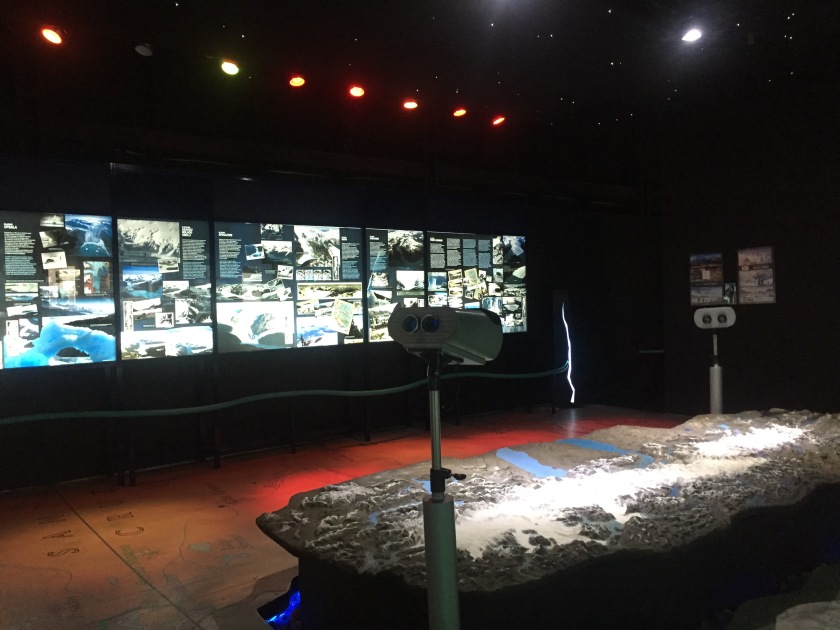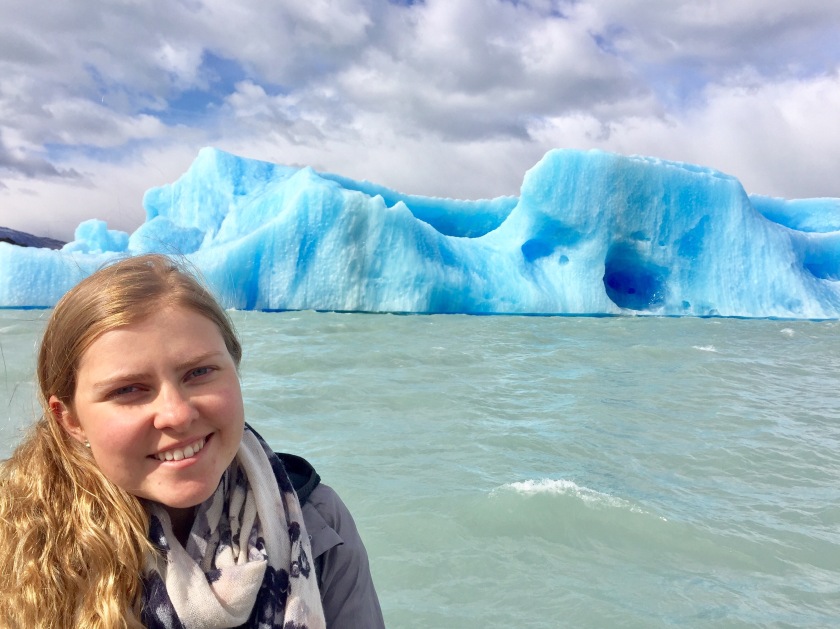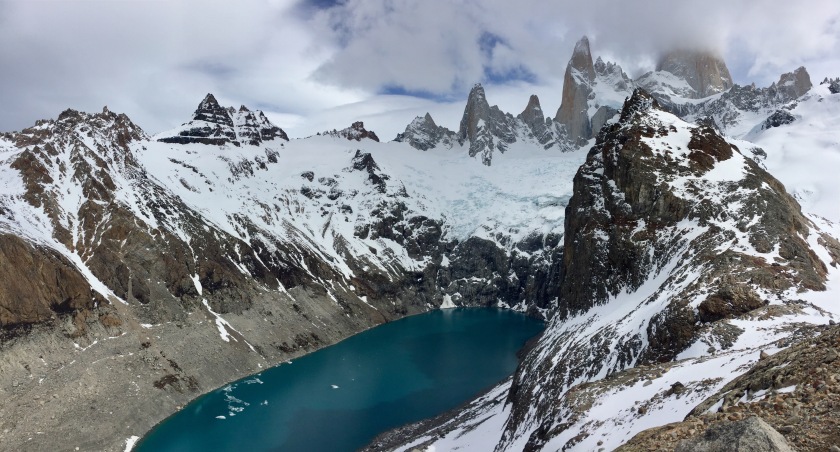Geographically central between the Lake District and Ushuaia, El Calafate is a very popular stop for travellers and has always been part of my itinerary from the beginning of my planning back in 2016. When I first saw a picture of the Perito Moreno glacier in my LP bible (Lonely Planet guidebook) I knew I had to make time in my trip to see it. If I’m honest I didn’t even know it was in Patagonia at the start, it’s famous in it’s own right and travellers come from around the world just to see it, but combined with the nearby town of El Chalten, it’s actually the frozen heart of Patagonia.
Perito Moreno glacier
The famous Perito Moreno glacier sits within Parque National Los Glaciares – a large area of glaciers, mountains and woodlands. In total there are 47 glaciers and it’s the biggest area of ice outside of Antarctica – that’s pretty impressive. The only downside about these amazing glaciers is they are very expensive to visit. Even just an unguided bus journey there and back costs £19.40 plus a park fee of £21.55. There are all kinds of activities you can do like trekking on the glacier and kayaking in the icy lake but seeing as my budget wasn’t able to stretch that far, I went with the regular bus.
You also get the longest amount time to see the glacier if you choose the bus option and after some pretty crappy guides so far on this trip, I decided a quick visit to the Glaciarium (glacier museum) the day before would give me all the information I would need. It even had a cool 3D cinema where you get to see real footage of lots of different glaciers in the national park as well as learning how they’re formed.
Perito Moreno is the most famous glacier in the national park and one of the few glaciers in the world that isn’t shirking due to climate change (it has a cyclical movement instead). The museum has a great time-lapse video of the glacier breaking off and reforming through winter to summer that explains this really well. This movement cycle has allowed a great network of viewing platforms to be built around the glacier’s peninsula, so that you can take in it’s colossal size and shape from all angles year in, year out.


I had five hours to wander around these platforms and take nearly 200 pictures of the impressive blue-looking glacier and it didn’t disappoint. It is just as spectacular in real life as it is in the pictures and even without blue skies it’s still stunning. I even managed to see a few chunks of ice break off – you can hear them crack and crash into the lake from most parts of the platform area. It’s a bit a strange to think I spent five hours watching a big ice sheet but unless you see it for yourself, you won’t understand its magnificence.
(I also got to see the condors that I had missed in Colca Canyon, Peru.)
Upsala & Spegazzini glaciers boat trip
Although I couldn’t afford to do the ice trekking, I could just about afford the boat trip Rios de Hielos (rivers of ice) where you get to see two other glaciers only accessible by boat (£86.22 + £21.55 park fees). It’s still pricey but there’s not much point in flying to El Calafate, paying to stay in hostels and not see what you’ve come to see.
I booked the boat trip through my hostel (America del Sur – hugely recommend them) and although no one else had signed but for this trip, I was excited to see something a bit extra to the Perito Moreno glacier. The trip includes a five hour boat ride through the Lago Argentina (Argentina’s largest lake) up to the Upsala and Spegazzini glaciers.
The Upsala glacier is a very large glacier that frequently breaks off so you can’t get very close to its face. It does have the advantage of producing lots of icebergs which float towards the lake. Our boat stopped by one huge iceberg (remember you only see about 10% of its surface area above the water) which looked so blue. It was quite an amusing tussle to get past other tourists to take pictures but anyone who is used to commuting in London can handle it. With the glaciers and snowcapped mountains reflecting the light from all angles, it can be quite hard to get good quality pictures but with just an iPhone 6, I did the best I could and almost dropped the phone into the water multiple times.
Next the boat goes to see the Spegazzini glacier (named after an Italian botanist, I think) which it’s safe to get very close to. The boat was so close it was actually a bit nerve-wracking but it was amazing to see the glacier’s pathway from the top of the mountain range curve down the mountainside to join the river. At this point it started to rain or snow but I tried my best to get to decent pictures. In the end I settled on a video panorama as the best way to really capture its immense size.
The boat trip was worth the high cost to see these amazing glaciers which are otherwise inaccessible. It was definitely worth the hostel-cooked pasta diet I’ve been on for the last two weeks to afford it.
El Chalten: Hiking to Laguna de los Tres and Laguna Torre
Near to El Calafate is a small town called El Chalten in the northern sector of Parque National Los Glaciares. It has loads of great hiking trails and thankfully you don’t have to pay the expensive park fees to hike there. It’s also home to the world-famous Mount Fitz Roy which stars on the American Patagonia clothing company’s logo.
I only had two days set side for El Chalten so I knew I would have to make the most of my time there. I had already researched the routes and planned out which hikes I wanted to do – I decided on Laguna de los Tres to the base of Mount Fitz Roy and Laguna Torre to base of the Torre mountains. The first is the most popular and supposedly the most challenging so I planned to tackle this on my first day, leaving the slightly less challenging for second when I would be a bit more tired and stiff. It turned out the weather was much better on my first day so I’m really glad I did do the routes this way around.
I set off early on the first day, reaching the start of the trail around 8:20am and having already joined forces with a couple from the hostel. They were a really nice American couple who had already been to my next stops in Patagonia so we spent a lot of time talking about those destinations. We chatted most of the way and before we knew it we’d reached 9km out of 10km without much difficulty. But this is where it started to get steeper and snowy. Except some of the snow was melting so it was quite slippy. I tried to find climbing routes through the rocks instead of the snow but this did make me quite tired. It was another hour before we reached the top but it was so worth all the hard work.
The views were amazing, even with misty clouds hugging to the peak of Fitz Roy. In front of us was a big white bowl of snow which we later decided must be one of the lakes. We enjoyed our packed lunches and rested for a bit after four hours of walking without any real breaks. At this point a few other travellers reached the top, including one Brit who said there was another lagoon just the otherwise of a rocky mound in front of us. We had decided we’d skip this lagoon and started back down the way we’d come before changing our minds. I cannot describe how glad I am we did change our minds. The lagoon was so picturesque – a clear, turquoise pool that stood out beautifully against the white and brown surroundings. It just enhanced the beauty of mountains and it’s certainly a gem that shouldn’t be missed if you walk all that way.
On the way down three more people joined our group and so we were quite a chatty hiking party on the way back, despite tired legs. It was really nice to walk with company instead of on my own and I really enjoyed the 20km without thinking about the distance for most of the day.
The next day the weather really wasn’t as good and although I felt really tired, I still went out to hike to the Laguna Torre. I’d seen some pictures of the lagoon before but they were clearly on a sunny day in the middle of summer because when I did reach it, it couldn’t have looked more different. I met two German girls I knew after the first 2km and joined their group for the rest of the way. We were quite upbeat but it was hard to shake my disappointment about the weather – I was definitely grateful I’d had a sunny day previously to see Fitz Roy.
On the way to the lagoon there is a tree graveyard of burnt trees from a recent fire that devastated parts of the woodland – caused by a careless trekker who didn’t put out a cigarette properly. It was eerie and sad to walk through and the thought that someone could be so thoughtless only makes my personal hate of smoking stronger.
The lagoon itself has a glacier feeding into it and when we reached it there were large chunks of ice floating in it. The water was dark and murky, and clouds covered the Cerro Torres which was supposed to be the main attraction of the hike. Despondent, our lunch was eaten in the rain and after taking all our pictures we quickly walked back to town. The 18km were definitely felt more keenly on the second day and I was very glad to reach the hostel at the end.
One good day out of two is pretty good weather-wise so I’m happy. El Chalten is a great warm-up for Torres del Paine, my next stop on my trip and Patagonia’s most famous (and expensive) hiking area.



















A stunning hike that I’ve read so much about and must do one day. Thanks for sharing!
LikeLike
The phone is delivering some great shots, Sammy. We love glaciers and have seen a few in our time so maybe we should follow your footsteps to visit these.
LikeLike